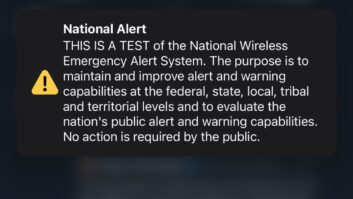Early indications are that the EAS test in West Virginia went well.
FEMA originated a Common Alerting Protocol-EAS message with a “National Periodic Test” event code and uploaded that at 2 p.m. Eastern yesterday to its IPAWS OPEN servers. This was the first such test of CAP-EAS with the NPT header code.
EAS encoders/decoders of stations in West Virginia polled the IPAWS EAS “Atom” feed, downloaded the message file that contained an audio file and aired it.
FEMA had also asked the stations to configure their EAS devices so the test could immediately be refed to other stations down the daisy chain.
Knowledgeable sources said early results indicate the test went well, though those involved are still gathering information.
West Virginia Broadcast Association Executive Director Michele Crist tells Radio World she’s heard from some 100 combined radio and TV stations that received and aired the test; she expected to hear from some 30 more as the day wears on. Most of the stations she’s heard from were able to retransmit the alert message, she said, noting a “handful,” possibly seven, could not retransmit it because they hadn’t correctly configured their EAS encoders/decoders.
Overall, “people said their signal was good,” she said. From her office in the state capital of Charleston, Crist said she monitored the test on several radio and TV stations and it looked and sounded “liked a normal EAS test.”
Indeed, we had reported earlier FEMA was going to add the word “national” to the familiar beginning: “This is a test of the national emergency alert system.”
FEMA will take the information gleaned from the test and add it to the agency’s knowledge base in preparation for a national EAS test in 2015, we’ve reported. The previous national EAS test used the legacy system and not CAP.











